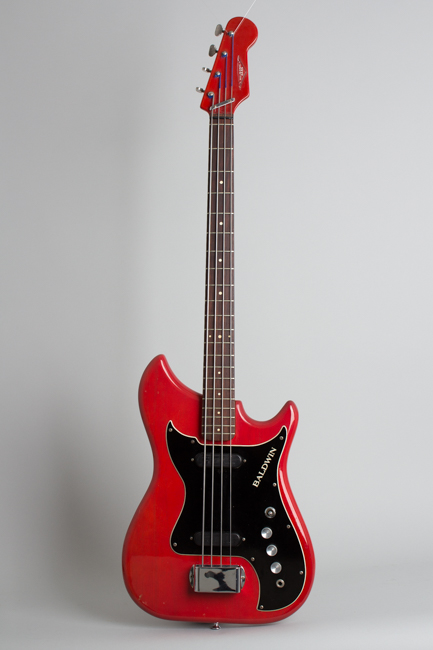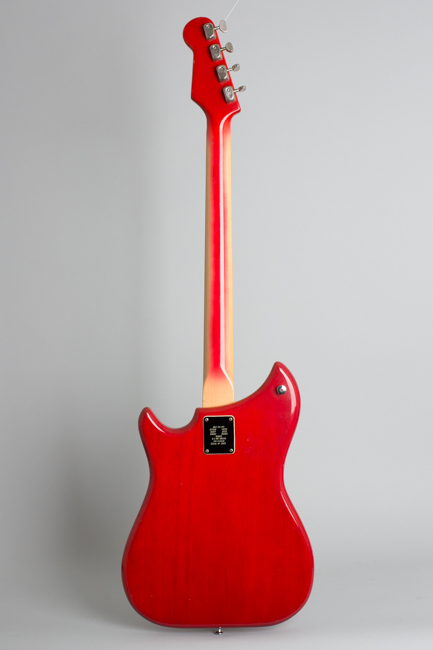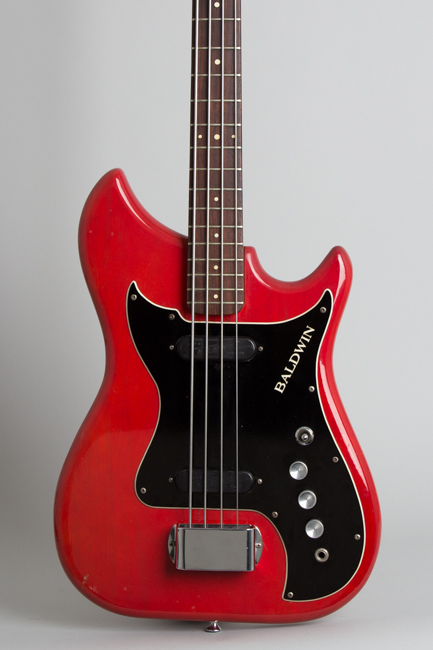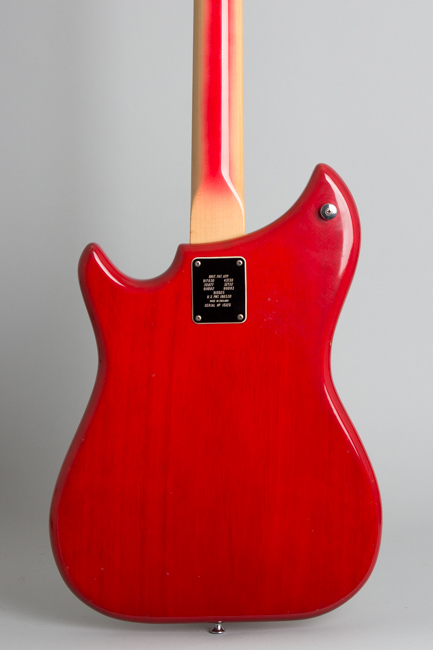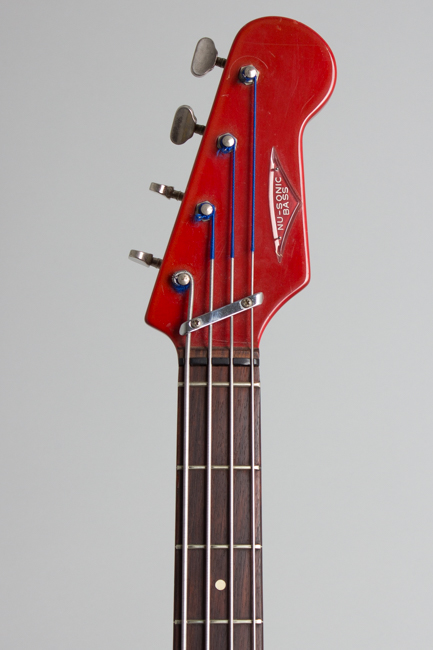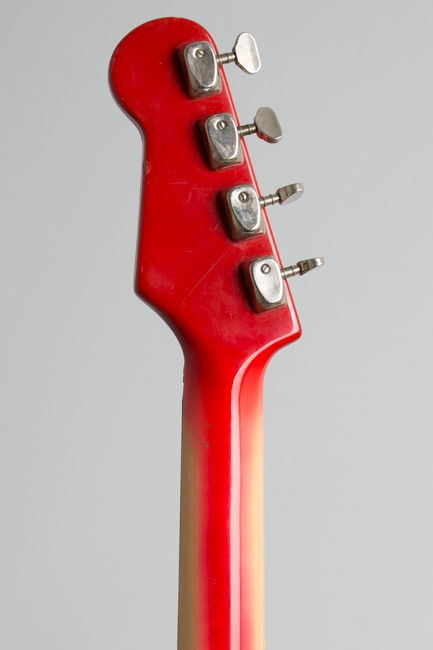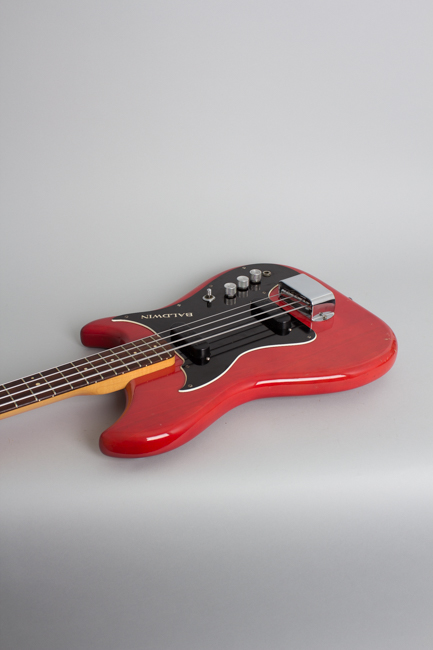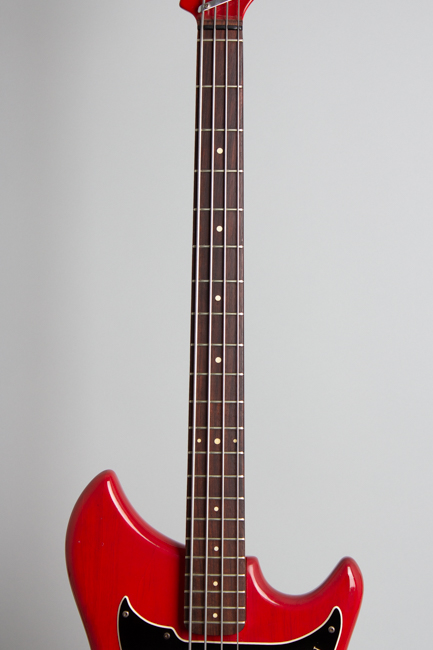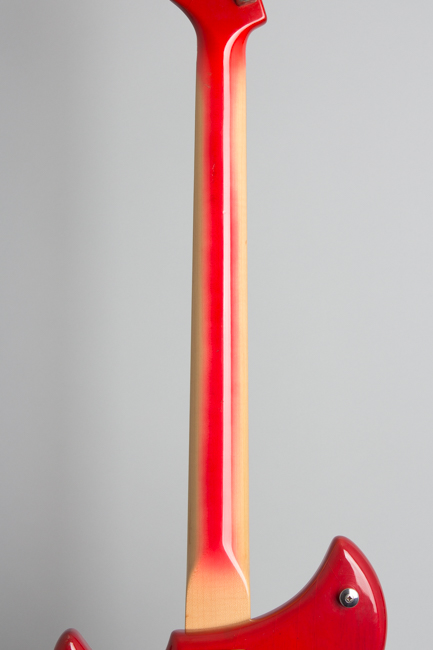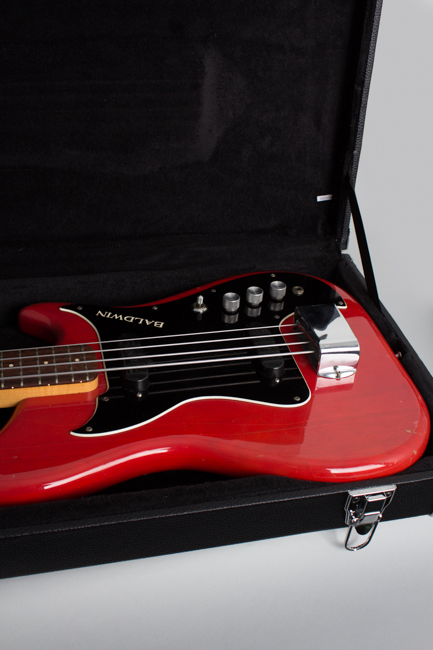Baldwin Burns Nu-Sonic Electric Bass Guitar (1966)
Item # 12454
Prices subject to change without notice.
Baldwin Burns Nu-Sonic Model Electric Bass Guitar (1966), made in London, England, serial # 15125, cherry polyester finish, obeche wood body, maple neck with rosewood fingerboard, black tolex hard shell case.
The Nu-Sonic guitar and bass were Burns of London's student-level instruments after mid-1964, replacing the original and by then rather outdated 1960 "Sonic" series. The Nu-Sonic (a typically Burnsian wordplay name) was offered in guitar and bass form with a choice of a cherry or black finish at around half the price of the flashy Bison or Marvin models. It is roughly the equivalent of Fender's Mustang, aimed at the same teenage market. Burns actually beat Fender to the punch here; the Mustang bass was not available until mid-1966.
This is a compact and very comfortable bass to play with quite a punchy tone. It is fitted out with two single-coil Nu-Sonic Pickups, 3-way switch, individual volumes and master tone. The simple but sturdy metal bridge has a single slanted saddle piece, adjustable for height and overall intonation. The small single sided "Fender-y" headstock is fitted with 4 enclosed Van Gent guitar-size tuners and a small "Nu-Sonic" badge on the face.
The Nu-Sonic models are both fun instruments to play had a sadly short shelf life. Despite its student intentions, the Nu-Sonic is a well-made bass and was actually not that cheap by contemporary standards. This may be why it was one of the first models discontinued by Baldwin after they bought the Burns company in September 1965. Both the guitar and bass disappeared from the line by fall '66 so the total production run was only about two years. Burns-labeled examples are quite rare, and Baldwin examples like this one only slightly less so.
There are photographs of George Harrison playing a cherry Nu-Sonic bass pulled from the Abbey Road storage locker for the April 1966 "Paperback Writer "sessions so this is considered a "borderline" Beatle instrument! Original Nu-Sonic basses are rather rarer then the guitars, and both the Beatle connection and their inherent appeal has made them one of the more sought-after original Burns instruments despite their budget status. The model was briefly reissued by the recent Burns company but even those were not made in large quantities. This Baldwin-logo example is still a cool Burns rarity and neat little player's bass.
Overall length is 42 in. (106.7 cm.), 13 1/4 in. (33.7 cm.) wide at lower bout, and 1 1/2 in. (3.8 cm.) in depth, measured at side of rim. Scale length is 30 in. (762 mm.). Width of nut is 1 3/4 in. (44 mm.).
This bass is nicely original and relatively clean overall; it shows some fairly light general wear and remains a very good player. There is less of the typical Baldwin finish checking than many and the finish retains a strong orange/red color; it is often quite faded on these. There are dings, scratches and dents to the finish overall but no particularly heavy wear.
All hardware is original, complete and in good shape including the oft-missing stamped bridge cover. The only repairs are the neck PU was rewound to original spec by Tom Brantley and the bridge pickup wax potted at the same time. The neck and frets are in excellent shape and this instrument plays extremely well, a superbly handy bass with a solid punchy sound. It lives in a modern HSC. Overall Excellent - Condition.
The Nu-Sonic guitar and bass were Burns of London's student-level instruments after mid-1964, replacing the original and by then rather outdated 1960 "Sonic" series. The Nu-Sonic (a typically Burnsian wordplay name) was offered in guitar and bass form with a choice of a cherry or black finish at around half the price of the flashy Bison or Marvin models. It is roughly the equivalent of Fender's Mustang, aimed at the same teenage market. Burns actually beat Fender to the punch here; the Mustang bass was not available until mid-1966.
This is a compact and very comfortable bass to play with quite a punchy tone. It is fitted out with two single-coil Nu-Sonic Pickups, 3-way switch, individual volumes and master tone. The simple but sturdy metal bridge has a single slanted saddle piece, adjustable for height and overall intonation. The small single sided "Fender-y" headstock is fitted with 4 enclosed Van Gent guitar-size tuners and a small "Nu-Sonic" badge on the face.
The Nu-Sonic models are both fun instruments to play had a sadly short shelf life. Despite its student intentions, the Nu-Sonic is a well-made bass and was actually not that cheap by contemporary standards. This may be why it was one of the first models discontinued by Baldwin after they bought the Burns company in September 1965. Both the guitar and bass disappeared from the line by fall '66 so the total production run was only about two years. Burns-labeled examples are quite rare, and Baldwin examples like this one only slightly less so.
There are photographs of George Harrison playing a cherry Nu-Sonic bass pulled from the Abbey Road storage locker for the April 1966 "Paperback Writer "sessions so this is considered a "borderline" Beatle instrument! Original Nu-Sonic basses are rather rarer then the guitars, and both the Beatle connection and their inherent appeal has made them one of the more sought-after original Burns instruments despite their budget status. The model was briefly reissued by the recent Burns company but even those were not made in large quantities. This Baldwin-logo example is still a cool Burns rarity and neat little player's bass.
Overall length is 42 in. (106.7 cm.), 13 1/4 in. (33.7 cm.) wide at lower bout, and 1 1/2 in. (3.8 cm.) in depth, measured at side of rim. Scale length is 30 in. (762 mm.). Width of nut is 1 3/4 in. (44 mm.).
This bass is nicely original and relatively clean overall; it shows some fairly light general wear and remains a very good player. There is less of the typical Baldwin finish checking than many and the finish retains a strong orange/red color; it is often quite faded on these. There are dings, scratches and dents to the finish overall but no particularly heavy wear.
All hardware is original, complete and in good shape including the oft-missing stamped bridge cover. The only repairs are the neck PU was rewound to original spec by Tom Brantley and the bridge pickup wax potted at the same time. The neck and frets are in excellent shape and this instrument plays extremely well, a superbly handy bass with a solid punchy sound. It lives in a modern HSC. Overall Excellent - Condition.
